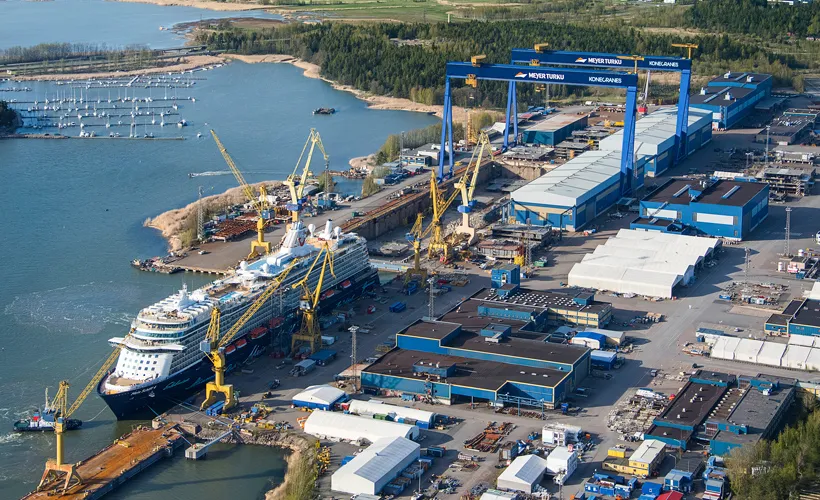An extensive network enables shipbuilding

When a ship deal worth billions is concluded, you can hear the champagne corks popping also in places other than just Turku Shipyard. The design and construction of a giant cruise ship is a joint effort by several companies acting as drivers in the project as well as hundreds of subcontractors around Finland. Konecranes is delivering an enormous crane to the shipyard, while a company from Turku is in charge of designing ship interiors. The illustration from Turku Shipyard shows the heights that the new crane from Konecranes reaches. In the background, you can see the old crane that will still continue to be used by the shipyard.
A globally exceptional maritime industry cluster has evolved in Finland. A study by Brahea Centre at the University of Turku indicates that the sea cluster is comprised of up to 3,000 companies. Their combined revenue is EUR 13 billion.
Roughly one-third of the sea cluster companies are located in Southwest Finland, with Turku Shipyard, owned by the Germany company Meyer, at the core of the cluster.
One of the most nostalgic moments at Turku Shipyard will take place in May next year when the enormous shipyard crane delivered by Konecranes will be ready for use. The company’s first Goliath shipyard crane was delivered more than 40 years ago and, as it happens, it was also delivered to Turku.
The old crane will continue to be used as well and its modernisation is currently under way. Moreover, Konecranes has concluded a maintenance agreement for both cranes.
“You simply cannot pass up these changes. This transaction is one of the most significant for us,” says Matti Malminen, Vice President, Trade & Export Finance, Trade Compliance at Konecranes.
The maximum height of the crane is 120 metres and its hoisting capacity is 1,200 tonnes. There is an interesting fact related to the welding stage: the shipyard that ordered the crane has operated as a subcontractor for Konecranes in welding the main support beam.
“All critical components come from Konecranes’ plants in Finland. The gearbox, electric systems and hoisting machinery are the heart of the crane,” explains Project Engineer Vesa Pietilä.
He has been involved in the crane project for nearly four years. The actual delivery time is two years.
Financing playing a key role in transactions
According to Pietilä and Malminen, a competent subcontracting network is the key to success for both Konecranes and the entire shipyard. The chain is extensive and quality and delivery reliability are required from subcontractors.
“We have invested heavily in the subcontractor network and want it to function smoothly. Companies are trained and monitored,” notes Malminen.
The value of the shipyard deal for Konecranes is EUR 35 million, only a fraction of the listed company’s revenue that exceeds EUR 3 billion.
International transactions amounting to tens of millions of euros often require financing arrangements. The so-called “Lex Jordan” gave Finnvera the opportunity to issue guarantees for domestic projects, too, provided that they promote Finnish exports. The crane delivery to Turku Shipyard is a good example of this.
“Finnvera and SEB Leasing Oy arranged the financing. As we speak, we have four other major export trade transactions in progress, in which buyer credit or Finnvera’s export credit guarantees play a significant role in securing the orders,” says Malminen.
Empowered by the network
According to Jari Suominen, Managing Director of Naval Interior Team (NIT), a company specialising in ship interior design, the Turku Shipyard cluster is one of the four most significant networks in the world. The three other networks are located in Germany, France and Italy, all connected with local shipyards.
“Turku’s best asset is that the network possesses the all-important technology. Elsewhere, shipyards keep it to themselves,” comments Suominen.
“Turku Shipyard is vital for us. It is easier to develop operations and introduce new innovations here,” he goes on to say.
The family business was founded at the beginning of the millennium and it has witnessed the decline and rebirth of Turku Shipyard. When the shipyard’s future hung in the balance under Korean ownership, the NIT management decided to enter international markets.
“We gained a foothold in German shipyards and in Japan. For a while, we also operated in France, but the biggest demand was in Japan. This enabled us to overcome,” says Suominen, thinking back.
A total of 75% of NIT’s more than EUR 77 million revenue comes from abroad. The company’s growth figures are impressive: a few years ago, its revenue was only one-tenth of the current level.
According to Suominen, NIT is one of the few turnkey suppliers in its field. The most significant success factor is cooperation with the shipyard, the shipping company and architects.
In ship projects, the company’s own employees operate as project directors, take care of design and purchasing, manage logistics and act as site supervisors. Materials and installation work are mainly provided by subcontractors.
“All solutions must be created from scratch. The key to a successful project is our competent team. It is extremely challenging to build efficient teams,” notes Suominen.
The Managing Director finds that Finnvera plays a significant role from the entire cluster’s point of view.
“We couldn’t have gone abroad without financing from Finnvera. Shipyards always require us to acquire a security. In addition, we need working capital in the design and production phase.”
Last year, the euro amount of new export credit guarantee applications received by Finnvera reached a record-breaking level, EUR 14.6 billion. The strong demand results especially from the order book growth in the shipbuilding industry.
Finnvera’s Regional Director Seija Pelkonen says that the success of the sea cluster reflects on the entire country and hundreds of companies. On the first level, there are turnkey suppliers, such as NIT. They need delivery securities and other project funding.
Financing-related needs trickle down in the network to the subcontractors of the turnkey suppliers, too.
“Companies now have a low threshold to launch international operations as there is another Meyer shipyard in Germany. Competence is cross-pollinated. Finnish subcontractors are also approached because they have a good reputation. We constantly receive inquiries about financing,” says Pelkonen.
FACTS: Drivers of exports, the sea cluster
- A study by Brahea Centre at the University of Turku indicates that the Finnish sea cluster is comprised of up to 3,000 companies. Half of these are limited companies, with information about their financial statements available.
- In 2015, the combined revenue of the sea cluster was EUR 13.0 billion and the companies had approximately 49,000 employees.
- The sea cluster companies concentrate in Uusimaa and Southwest Finland. Brahea Centre’s study reveals that almost a third of the sea cluster companies are located in the Turku region.
- The core of the cluster in Turku is the shipyard. The shipyard’s order book extends all the way to 2024 and includes eight passenger ships.
- Southwest Finland also boasts a growing automotive and mining industry cluster.
- Customs’ statistics for the first half of the year show that, as an export region, Southwest Finland comes second in Finland in terms of euros and third in terms of the number of export companies.
- Read more about credit risks in export trade here.
- Read more about our working capital for export products here.
- Read more about financing for the buyer here.
Read also: Finnvera to contribute more than EUR 2.5 billion to cruise ship financing
